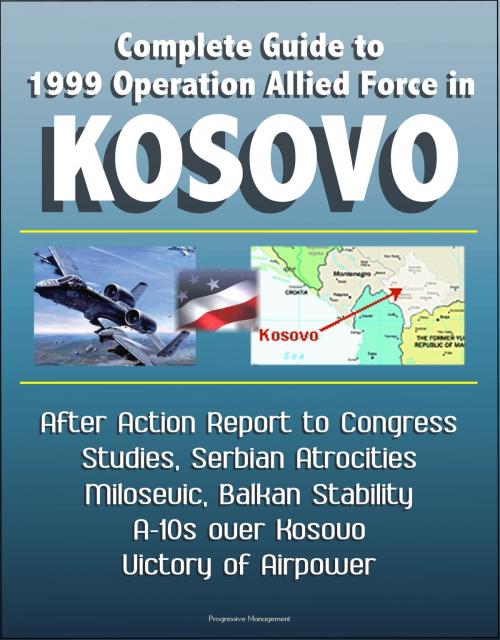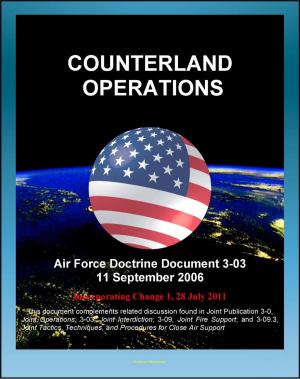Complete Guide to 1999 Operation Allied Force in Kosovo: After Action Report to Congress, Studies, Serbian Atrocities, Milosevic, Balkan Stability, A-10s over Kosovo, Victory of Airpower
Nonfiction, History, Baltic States, Military, Aviation| Author: | Progressive Management | ISBN: | 9781301517169 |
| Publisher: | Progressive Management | Publication: | September 6, 2013 |
| Imprint: | Smashwords Edition | Language: | English |
| Author: | Progressive Management |
| ISBN: | 9781301517169 |
| Publisher: | Progressive Management |
| Publication: | September 6, 2013 |
| Imprint: | Smashwords Edition |
| Language: | English |
Four major ebooks are included in this massive compilation of official reports and studies about the 1999 intervention by NATO and the Clinton Administration in Kosovo known as Operation Allied Force. It provides a complete review of this important event in world history.
SECTION 1: Kosovo and Operation Allied Force After-Action Report - Report To Congress - Operational Perspective * Purpose of the Report * Organization of the Report * EXECUTIVE SUMMARY * Lessons Learned * Men and Women in Service * NATO Contributions * Improving Allied Military Capabilities * Target-Approval Process * Bombing of the Chinese Embassy in Belgrade * Relationship with Russia * Effect on Our Capability To Fight Two Major Theater Wars * Ground Operation * Absence of Combat Fatalities * Command, Control, Communications, and Computers * Intelligence, Surveillance, and Reconnaissance * Preferred Munitions * Air Defense Suppression * Logistics and Deployment * I. GEOPOLITICAL CONSIDERATIONS * A. Prelude to Conflict * 1. Background on the Conflict * 2. Interests at Stake * 3. Reaffirming the Alliance * B. The Campaign Over Kosovo * 1. An Asymmetric Conflict * 2. U.S. and NATO Strategic Objectives * 3. Phases of the Campaign * 4. Status of a Ground Forces Plan * 5. Conditions To End the Operation * 6. Role of Diplomacy * 7. Mandate and Legal Basis * C. Why Did Milosevic Capitulate? * D. Implications for U.S. Defense Strategy
SECTION 2: The Final Status of Kosovo and its Implications for Balkan Stability - This study presents the possible scenarios for the final political status of Kosovo, undecided since 1999, and the implications of these scenarios for the stability of the Balkans. In the beginning, basic elements of theory about the reconstruction of war-torn societies are presented in terms of such aspects as security, governance, economy, and justice. The goal is an understanding of the current situation in Kosovo, the challenges that the international administration had to handle when it arrived in Kosovo in June 1999, and its achievements and weaknesses till now. Finally, the possible scenarios for Kosovo's final status are examined and the one best for regional stability is suggested.
SECTION 3: Military Studies of Operation Allied Force - Part 1: Religious and Ethnic Warfare: The Kosovo Case * Part 2: Analysis of the Modern Inter-Ethnic Conflict: Case Study of Kosovo * Part 3: Humanitarian Intervention in Kosovo: The Importance of Legal and Moral Issues * Part 4: Operation Allied Force - Golden Nuggets for Future Campaigns * Part 5: Targeting After Operation Allied Force: Has The Law Changed For CINCS and Their Planners? * Part 6: Standing Naval Force Mediterranean Operations in Support of Operation Allied Force: A Qualitative Review for the Joint Task Force Commander * Part 7: Operation Allied Force: Reachback and Information Processes * Part 8: Operational Leadership in Kosovo * Part 9: Tactical Control of Air Mobility Forces in Operation Allied Force: Is This The Way Things Should Be Done? * Part 10: Clausewitz on Kosovo * Part 11: Serbian Information Operations During Operation Allied Force * Part 12: Coercion and Land Power * Part 13: Operation Allied Force: Case Studies in Expeditionary Aviation - USAF, USA, USN, and USMC * Part 14: Operation Allied Force: Setting a New Precedent for Humanitarian Intervention?
SECTION 4: A-10s over Kosovo: The Victory of Airpower over a Fielded Army - This book's objectives are to include firsthand accounts by those who participated and share the observations and conclusions seen from their tactical points of view. Chapter 1 establishes the overall context of the A-10 involvement in OAF and includes a description of participating units, their aircraft, and their weapons capabilities. It discusses mission types and typical missions, daily operations cycles, and theater geography and force-beddown locations.
Four major ebooks are included in this massive compilation of official reports and studies about the 1999 intervention by NATO and the Clinton Administration in Kosovo known as Operation Allied Force. It provides a complete review of this important event in world history.
SECTION 1: Kosovo and Operation Allied Force After-Action Report - Report To Congress - Operational Perspective * Purpose of the Report * Organization of the Report * EXECUTIVE SUMMARY * Lessons Learned * Men and Women in Service * NATO Contributions * Improving Allied Military Capabilities * Target-Approval Process * Bombing of the Chinese Embassy in Belgrade * Relationship with Russia * Effect on Our Capability To Fight Two Major Theater Wars * Ground Operation * Absence of Combat Fatalities * Command, Control, Communications, and Computers * Intelligence, Surveillance, and Reconnaissance * Preferred Munitions * Air Defense Suppression * Logistics and Deployment * I. GEOPOLITICAL CONSIDERATIONS * A. Prelude to Conflict * 1. Background on the Conflict * 2. Interests at Stake * 3. Reaffirming the Alliance * B. The Campaign Over Kosovo * 1. An Asymmetric Conflict * 2. U.S. and NATO Strategic Objectives * 3. Phases of the Campaign * 4. Status of a Ground Forces Plan * 5. Conditions To End the Operation * 6. Role of Diplomacy * 7. Mandate and Legal Basis * C. Why Did Milosevic Capitulate? * D. Implications for U.S. Defense Strategy
SECTION 2: The Final Status of Kosovo and its Implications for Balkan Stability - This study presents the possible scenarios for the final political status of Kosovo, undecided since 1999, and the implications of these scenarios for the stability of the Balkans. In the beginning, basic elements of theory about the reconstruction of war-torn societies are presented in terms of such aspects as security, governance, economy, and justice. The goal is an understanding of the current situation in Kosovo, the challenges that the international administration had to handle when it arrived in Kosovo in June 1999, and its achievements and weaknesses till now. Finally, the possible scenarios for Kosovo's final status are examined and the one best for regional stability is suggested.
SECTION 3: Military Studies of Operation Allied Force - Part 1: Religious and Ethnic Warfare: The Kosovo Case * Part 2: Analysis of the Modern Inter-Ethnic Conflict: Case Study of Kosovo * Part 3: Humanitarian Intervention in Kosovo: The Importance of Legal and Moral Issues * Part 4: Operation Allied Force - Golden Nuggets for Future Campaigns * Part 5: Targeting After Operation Allied Force: Has The Law Changed For CINCS and Their Planners? * Part 6: Standing Naval Force Mediterranean Operations in Support of Operation Allied Force: A Qualitative Review for the Joint Task Force Commander * Part 7: Operation Allied Force: Reachback and Information Processes * Part 8: Operational Leadership in Kosovo * Part 9: Tactical Control of Air Mobility Forces in Operation Allied Force: Is This The Way Things Should Be Done? * Part 10: Clausewitz on Kosovo * Part 11: Serbian Information Operations During Operation Allied Force * Part 12: Coercion and Land Power * Part 13: Operation Allied Force: Case Studies in Expeditionary Aviation - USAF, USA, USN, and USMC * Part 14: Operation Allied Force: Setting a New Precedent for Humanitarian Intervention?
SECTION 4: A-10s over Kosovo: The Victory of Airpower over a Fielded Army - This book's objectives are to include firsthand accounts by those who participated and share the observations and conclusions seen from their tactical points of view. Chapter 1 establishes the overall context of the A-10 involvement in OAF and includes a description of participating units, their aircraft, and their weapons capabilities. It discusses mission types and typical missions, daily operations cycles, and theater geography and force-beddown locations.















